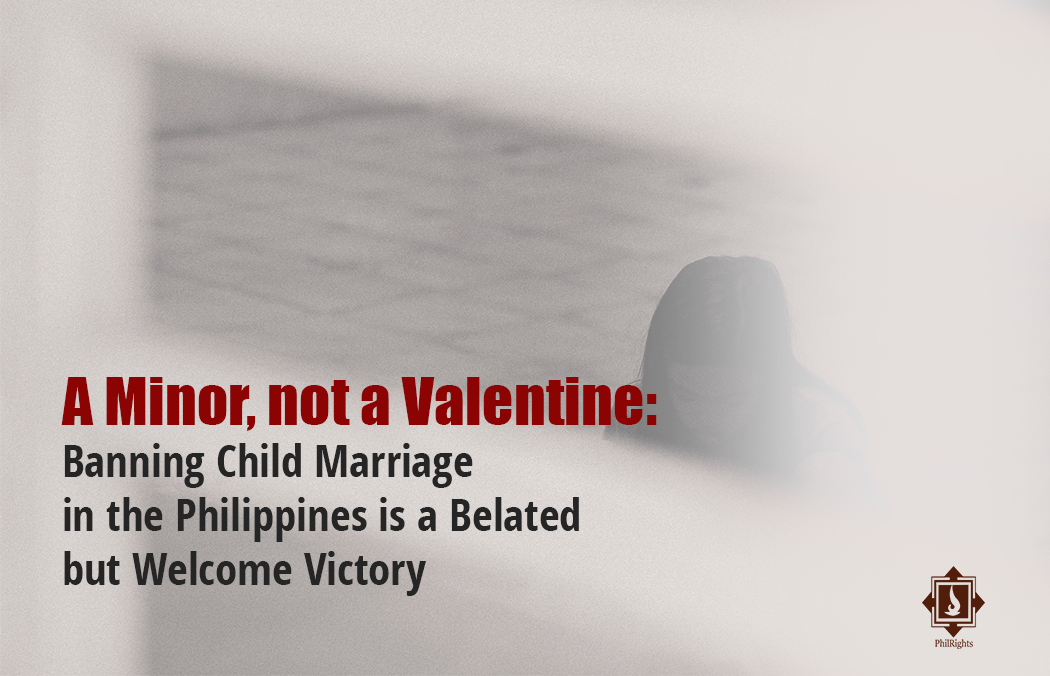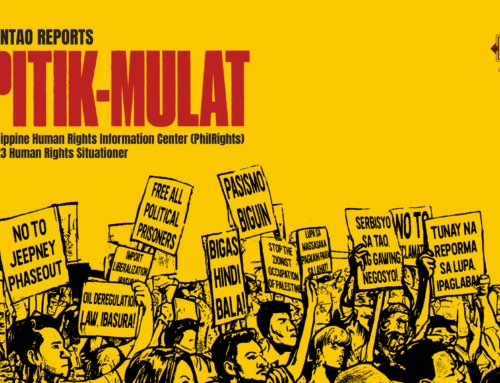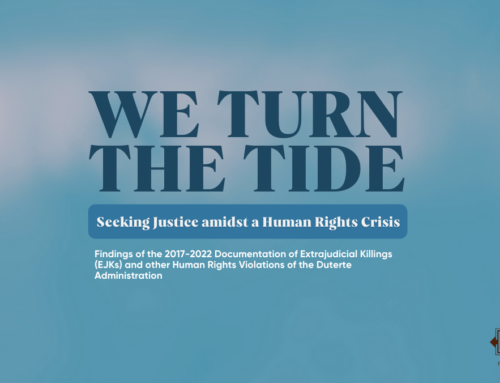by Isaiah Castro
The prohibition of child marriage in the Philippines is a welcome victory for Filipino children and children’s rights and a clear step into the right direction, even as it should not have taken this long.
President Rodrigo Duterte earlier this year signed Republic Act No. 11596 into law, which banned all forms of child marriage in the country. The consolidated measure imposes penalties on facilitation and solemnization of child marriage, and the cohabitation of an adult with a child outside wedlock. Violators who are discovered to be public officials may be dismissed or perpetually disqualified from assuming office should the courts deem it so.
Prior to the recent statute, Presidential Decree No. 1083 or the Code of Muslim Personal Laws, which is partly based on Sharia law, allowed indigenous Muslims to get married as minors. This is an exception to the existing Family Code which does not sanction the rest of the nation to marry before reaching age of majority at 18 years old.
With the new law, the National Commission on Muslim Filipinos, along with the Department of Social Welfare and Development and other implementing agencies, is now obligated to raise awareness on the grim effects of forced marriage on child brides and child grooms. Fortunately, the negative impacts of child marriage are well documented.
According to international network Girls Not Brides, 17 percent of Filipino girls are married before their 18th birthday and 2 percent are submitted into marriage even before the age of 15. The same research shows that the Philippines has the 10th highest number of females married or in a union before the age of 18, that is 808,000 young Filipinas, most of which come from Soccsksargen, Mimaropa, and Eastern Visayas regions. These provinces hold some of the highest poverty incidence rates in the country.
For UNICEF, child marriage “ends childhood.” And while it may happen to boys and girls, the latter is affected disproportionately. It crosses human rights and places its victims at higher risks of violence, exploitation, and abuse. Furthermore, it backtracks children’s rights to education, health, and protection. A girl bride is more likely to be out of school and have lesser access to reproductive healthcare, hence resulting to greater chances of her dying due to complications during pregnancy and childbirth. In the case of India and other developing states like the Philippines, child marriage is detrimental to economic growth and upskilling of human capital. UNICEF explains that child grooms and brides more likely lack the skills and knowledge that match career prospects, hindering them from landing a job and contributing to family needs that may lift them out of poverty. While its occurrence is gradually declining across the globe, the religious, cultural, and social pressures that enable child marriage persist and threaten the progress made for decades.
The Philippine Commission on Women, for their part, lauded the passage of RA 11596, reasoning that this reflects the Congress’ “firm resolve” to carry out the Implementing Rules and Regulations of the Magna Carta of Women and uphold the country’s previous commitments under international law, including the Convention on the Elimination of all Forms of Discrimination Against Women (CEDAW) in 1981 and the Convention on the Rights of the Child (CRC) in 1990.
Civil society organizations under the Child Rights Network (CRN) also hailed the passage of the new law and its aim to deter the prevalence of child marriages in the country. “This is a ray of hope for children’s rights legislation in the Philippines,” said CRN Convenor Romeo Dongeto, “Child rights advocates will take this victory as inspiration in launching more comprehensive campaigns in the name of paving a better future for Filipino children.”
Other than religion and laws in Muslim Mindanao, studies show that the complex interplay of armed conflict, displacement, and poverty drives rates of child marriage in the Philippines. During the Marawi siege crisis in 2017, for instance, 31 percent of people in the evacuation sites reported that child and forced marriage are the most common form of gender-based violence. According to United Nations Population Fund (UNFPA), protracted displacement in the Bangsamoro region resulted in a rise of child marriage cases, as it is identified to be among the coping mechanisms of stranded families who are facing economic instability, fear of violence, and a felt need to maintain “family honor.” In places where civil conflict or crime rates against women remain high, girls are married off to secure a flimsy sense of protection.
Under the COVID-19 pandemic, a survey by Plan International Philippines showed that young girls and women were most concerned with their mental health, sexual and reproductive health, education, and the disruption in economic life causing job and food insecurity and domestic violence. Reported incidents of domestic violence and sexual harassment have also increased, the most common of which is verbal abuse worsened by social media activity.
These issues highlight the fact that child marriage is one particularly abhorrent practice that speaks to the larger societal problems with regards to valuing the rights and well-being of children in general and girls, specifically. Thus, the end of child marriage in the Philippines should inevitably be backed by adolescent empowerment, sex education and reproductive health services, and other top-down government programs that safeguard the enforcement of the new law while addressing the complex and entrenched nature of the problem. It demands an upheaval on the socio-cultural and structural factors that push children to premature marriage, alongside further recovery efforts from the effects of the COVID-19 pandemic.
The UNFPA and UNICEF are leading a joint effort to combat the practice across the world, known as the Global Programme to Accelerate Action to End Child Marriage. Their efforts include empowering teenage girls at risk of or involved in child marriage through knowledge of their rights; mobilizing families to invest in adolescent girls and engage men and boys in the fight against child marriage; and strengthening accessibility, quality and responsiveness of services especially in education, health, child and social protection. More importantly, these require a gender-transformative approach that not only fosters critical examination of gender roles, children’s welfare, human inequality, and the intersectionalities in between, but also augments the rich body of knowledge that informs policymaking and legislation.
Indeed, the new law prohibiting child marriage is an achievement of years of campaign. Without minimizing its immediate impact, we also need to recognize its potential for trailblazing a slew of actions that can further weaken social and legal pressures that rid minors, and even adults, of their bodily autonomy and well-being.
For instance, the gridlock to permit divorce in the last country in the world to ban so is also a struggle to provide redress to partners in couples who have fallen to child marriage and violence. Meanwhile, the rampancy of online sexual exploitation of children (OSEC) and cataloging of mail-order brides who cater to foreign nationals put minors at harm’s way, oftentimes at the hands of their own parents or guardians themselves.
All these battles fuel an unwavering drive to fight for the abolition of modern-day slavery and abuse of children. What is at stake is difficult to understate and the cost of failure even more difficult to accept.








